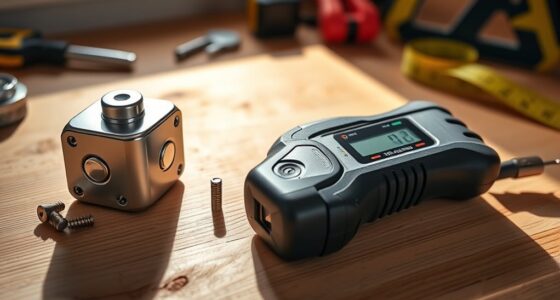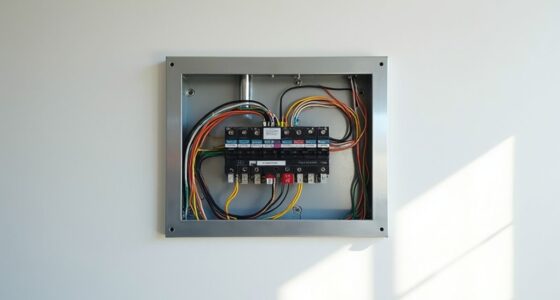A smart thermostat can save you about 8% on your utility bills, which adds up to roughly $50 annually. If you live in an extreme climate, those savings can jump to 23%, equating to around $200 each year. It uses features like learning algorithms and geofencing to optimize energy use based on your habits. Curious to discover more ways a smart thermostat can boost your home’s efficiency and comfort?
Key Takeaways
- Smart thermostats can reduce utility bills by an average of 8%, equating to approximately $50 in annual savings.
- In extreme climates, potential savings may increase to 23%, leading to around $200 in yearly savings.
- Energy efficiency strategies, like combining with Ground Source Heat Pumps, can enhance savings further.
- Features like geofencing and learning algorithms optimize energy use based on occupancy and user habits.
- Compatibility with HVAC systems is crucial; ensuring a C-wire is available maximizes energy savings potential.
Understanding Smart Thermostats and Their Functionality
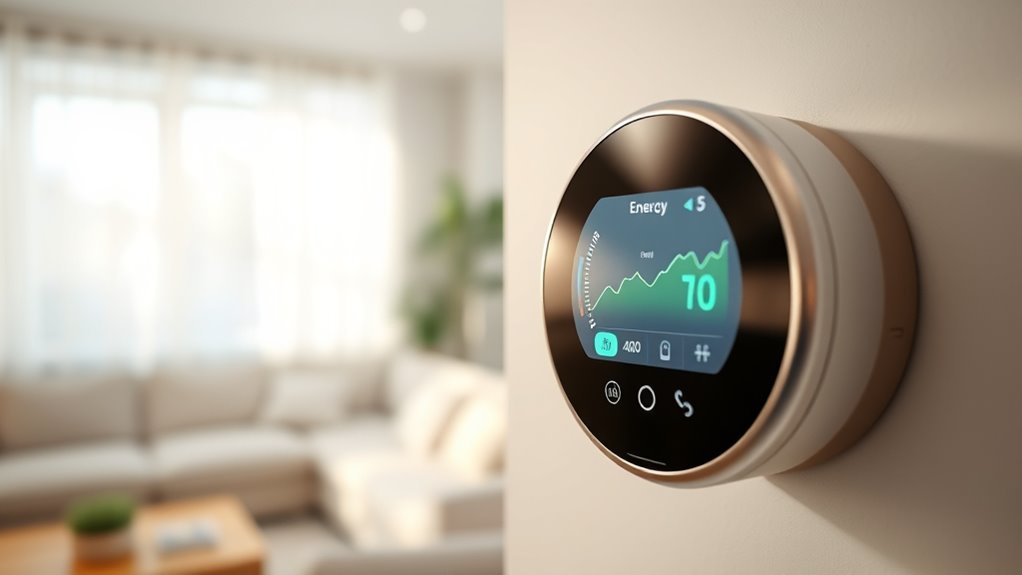
Although you might be familiar with traditional thermostats, smart thermostats take user control to the next level by utilizing Wi-Fi connectivity, allowing you to manage your heating and cooling systems from anywhere using your smartphone.
These devices employ learning algorithms to analyze your habits and create personalized schedules that enhance energy efficiency and comfort. Additionally, using quality gear can help ensure that your HVAC system operates at its best, contributing to overall energy savings. Heat pumps can reduce energy consumption by up to 50%, making smart thermostats an even more valuable addition to an efficient heating and cooling strategy.
Smart thermostats use learning algorithms to tailor schedules to your habits, boosting both comfort and energy efficiency.
With features like geofencing technology and motion sensors, smart thermostats automatically make temperature adjustments based on occupancy, minimizing energy waste.
You’ll also receive energy usage data, giving you insights into your consumption patterns and identifying potential areas for energy savings.
Verify your existing HVAC system is compatible, as some smart thermostats may require a C-wire for peak operation. Furthermore, integrating a smart thermostat with a heat pump system can further optimize energy usage and enhance overall efficiency.
Potential Energy Savings From Smart Thermostats

When you invest in a smart thermostat, you’re not just upgrading your home’s temperature control; you’re also paving the way for considerable energy savings.
Smart thermostats can reduce your utility bills by an average of 8%, leading to about $50 in annual savings. In extreme climates, this figure can climb even higher. Some brands boast savings of up to 23% on heating and cooling costs, translating to approximately $200 annually. Additionally, implementing energy efficiency strategies in your home can complement the benefits of a smart thermostat. Integrating a smart thermostat with a Ground Source Heat Pump can significantly enhance energy efficiency and savings. Geothermal energy utilization in conjunction with smart technology can further optimize these savings. Proper planning of energy consumption can further optimize these savings.
To maximize these financial benefits, consider these features:
- Motion sensors that adjust temperatures when you’re away
- Geofencing technology that tracks your location
- Learning algorithms for ideal energy efficiency
- Easy integration with your smart home devices
- Utility company rebates to offset initial investment
Additionally, when combined with geothermal heat pumps, smart thermostats can further enhance energy efficiency and savings.
Your long-term savings can greatly outweigh the upfront costs.
Key Features That Enhance Energy Efficiency
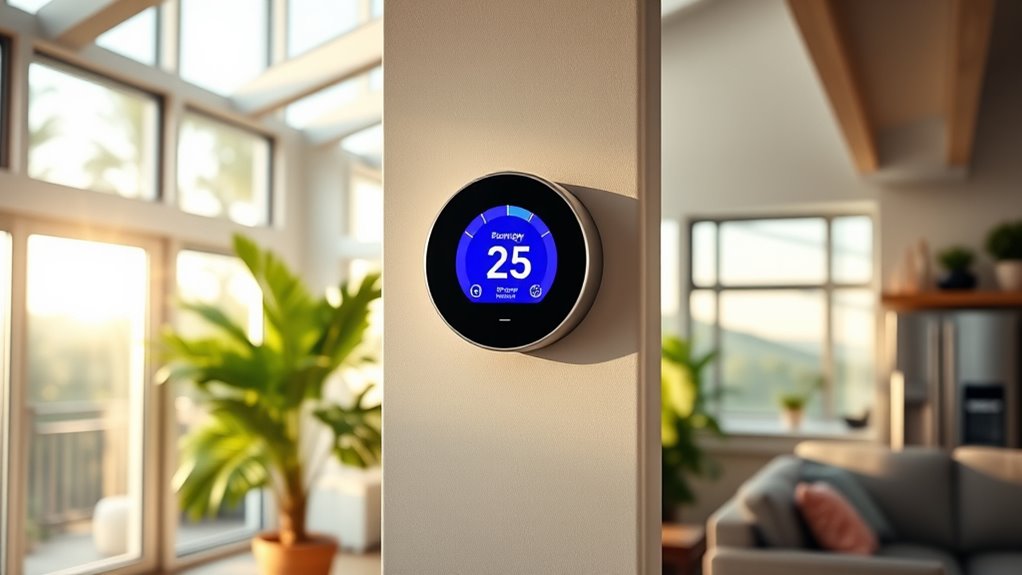
Investing in a smart thermostat not only boosts your home’s comfort but also introduces features that notably enhance energy efficiency. These devices utilize advanced technology to help you save money on utility bills. Here are some key features:
| Feature | Description | Benefit |
|---|---|---|
| Geofencing | Adjusts temperature based on your location | Conserves energy when away |
| Learning Capabilities | Adapts to your habits over time | Creates efficient schedules |
| Energy Usage Reports | Tracks consumption patterns | Informs adjustments |
| Remote Temperature Sensors | Optimizes comfort in specific rooms | Applies heating/cooling where needed |
| Optimize Heating & Cooling | Automatically adjusts settings | Enhances energy efficiency |
With these features, you can effectively adjust temperature settings and noticeably improve energy efficiency in your home. Additionally, smart thermostats can work in conjunction with modern heat pumps to further enhance overall energy savings and comfort. By integrating smart technology into your HVAC system, you can monitor and optimize energy use more effectively. Furthermore, utilizing energy-efficient devices such as air purifiers can contribute to a healthier indoor environment and lower overall energy consumption. Regular appliance maintenance can also play a key role in maximizing energy efficiency in your home, ensuring your systems operate smoothly and effectively. Moreover, implementing HEPA filtration in your air purifiers can help reduce allergens, further improving the air quality and efficiency of your HVAC system.
Factors Influencing Energy Savings

Several factors can considerably influence the energy savings you achieve with a smart thermostat. Understanding your unique usage patterns is key.
Here are some critical elements to reflect on:
- Occupancy patterns: Frequent absence from home can lead to significant savings. Homes with security systems are often monitored for occupancy, which can help in optimizing energy use. Additionally, implementing energy-efficient practices can further enhance your home’s overall energy management. Incorporating multi-functional gear in your home can also contribute to better energy efficiency by ensuring that devices serve more than one purpose. Furthermore, utilizing energy-efficient heat pumps can complement your smart thermostat’s functionality for improved savings.
- Existing programmable thermostats: If you already have one, your savings may be limited.
- Temperature settings: Setting ideal temperatures can optimize energy consumption.
- Geofencing and motion sensors: These features adjust heating and cooling automatically, saving energy when you’re away.
- Energy-efficient practices: Taking advantage of utility programs can enhance your overall savings.
Additionally, the implementation of enhanced infrastructure resilience can further support your energy efficiency goals by minimizing disruptions that affect energy consumption.
Evaluating Your Home’s Compatibility and Installation Considerations
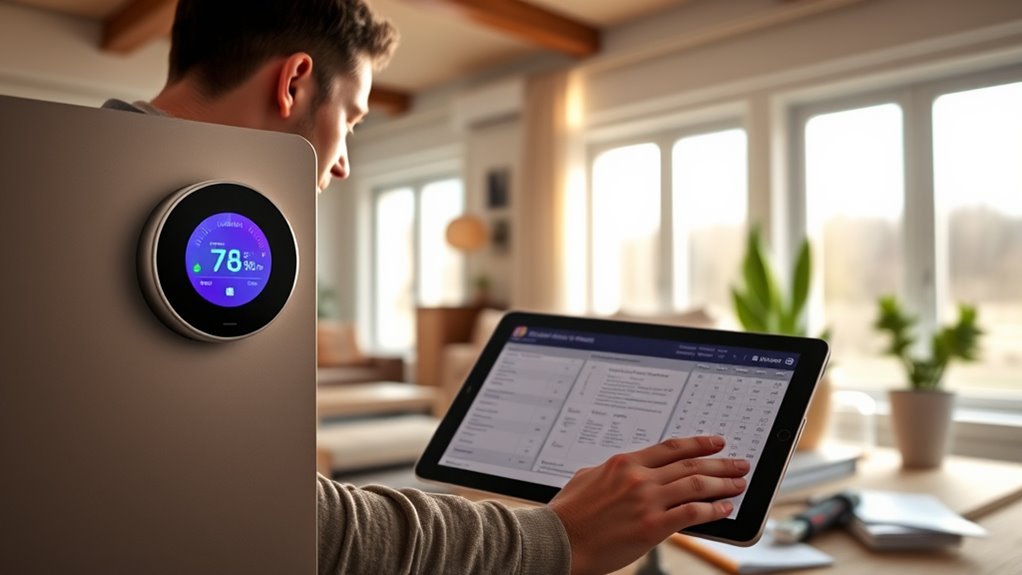
Understanding the factors influencing energy savings sets the stage for evaluating your home’s compatibility with a smart thermostat. First, check your HVAC system for compatibility, especially regarding the C-wire. Many smart thermostats require this for proper functionality. Additionally, incorporating energy-efficient designs into your overall home setup can further enhance savings and sustainability. Investing in Gold IRAs can also be a strategic financial move as you save on utilities, allowing for greater funds to allocate towards long-term investments. Regular maintenance of your heat pump can improve its efficiency by up to 70%, contributing to even greater energy savings. Furthermore, a well-rounded investment strategy, such as diversification, can help ensure that your financial future remains stable while you reduce monthly expenses.
| Aspect | Considerations | Action |
|---|---|---|
| Compatibility | Check if your system supports smart models | Review user manuals |
| C-wire | Determine if a C-wire is present | Install adapters if needed |
| Wiring | Assess if current wiring meets requirements | Consult a professional |
| Installation | DIY vs. professional help | Choose based on complexity |
| Accessories | Look for necessary add-ons | Purchase before installation |
Additionally, ensuring effective ventilation in your bathroom can significantly enhance air quality, which complements the benefits of smart thermostats in maintaining a comfortable environment.
Frequently Asked Questions
Do Smart Thermostats Actually Save Energy?
Yes, smart thermostats do save energy. They learn your habits and adjust temperatures when you’re away, optimizing heating and cooling for efficiency.
With features like geofencing and programmable schedules, they guarantee your home remains comfortable while minimizing unnecessary energy use.
You’ll likely notice a drop in your utility bills as these devices adapt to your lifestyle, making your home both energy-efficient and cost-effective.
Embracing this technology can lead to significant savings over time.
Is There a Downside to Smart Thermostats?
While smart thermostats can save an average of 8% on utility bills, they mightn’t be the perfect fit for everyone.
You could run into compatibility issues if your HVAC system isn’t up to date, which may lead to costly installations.
Plus, the complex features can feel overwhelming, causing you to underutilize the device.
If you already have a programmable thermostat, the potential savings might be minimal, making the switch less worthwhile.
How Much Energy Does 1 Degree on a Thermostat Save?
Adjusting your thermostat by just 1 degree can save you about 1% on your heating and cooling costs.
This means if you lower your thermostat in winter or raise it during summer, you could see annual savings of $10 to $30.
By making small changes regularly, you can accumulate significant energy savings over time.
Is 74 a Good Temperature to Save Money on Electricity?
Ah, the age-old quest for comfort and savings!
Setting your thermostat to 74°F is a savvy move if you want to save money on electricity. This temperature strikes a delightful balance, allowing you to stay comfortable while cutting cooling costs.
Conclusion
To summarize, investing in a smart thermostat can greatly cut your energy bills while keeping your home comfortable. You might worry about the upfront cost, but the long-term savings often outweigh that initial expense. Plus, with features like scheduling and remote control, you’ll have greater flexibility and convenience. So, why not embrace this technology? By making your home more energy-efficient, you’re not just saving money; you’re also contributing to a greener planet for everyone.



